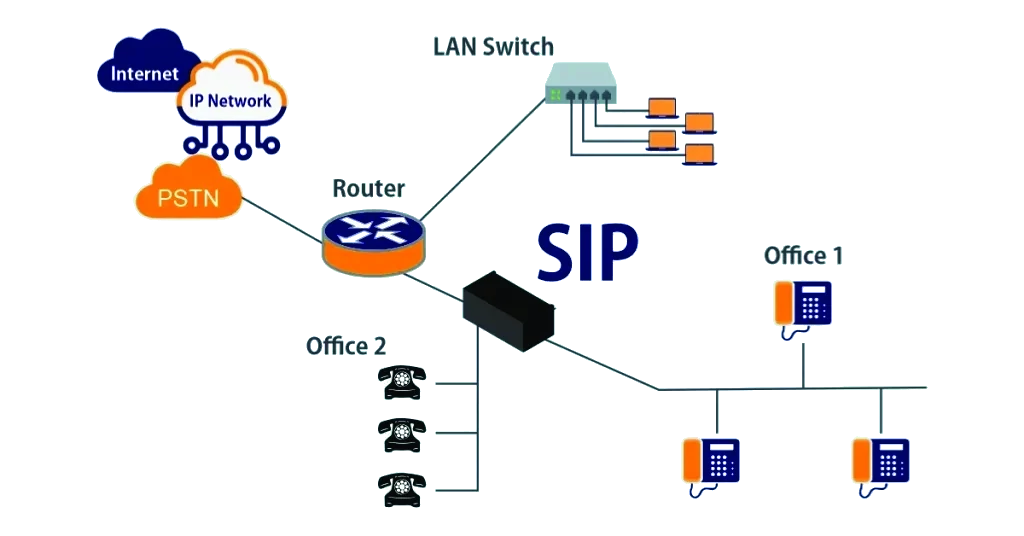SIP trunk (Session Initiation Protocol trunk) is a technology that allows businesses to make and receive phone calls over the internet instead of traditional phone lines. Think of it as a virtual phone line that connects your phone system (PBX) to the internet, enabling voice, video, and messaging services. SIP trunks are popular because they’re cost-effective, scalable, and offer better flexibility—especially for companies with remote teams or global operations. If you’re looking to modernize your business communications or reduce telecom costs, SIP trunking is a smart, future-ready solution.
SIP trunking offers several advantages, including lower call costs, better flexibility, and easier integration with modern communication systems like video conferencing and messaging. It eliminates the need for physical phone lines and simplifies infrastructure by using a single internet connection for both voice and data. Additionally, SIP trunks support features such as caller ID, direct inward dialing (DID), and disaster recovery options, making them a popular choice for modern unified communication solutions.
This article explores the importance of international SIP trunking and reviews the key factors to consider when selecting providers with the best global reach.
Why International SIP Trunking Matters
In today’s hyper-connected global economy, effective and affordable international communication is no longer a luxury—it’s a necessity. Whether you’re a multinational corporation, a growing e-commerce brand, or a customer support center catering to overseas clients, maintaining seamless voice communication across borders is critical. That’s where international SIP trunking comes into play.
Traditional phone systems and legacy PBX infrastructures often come with limitations—high international call charges, inconsistent call quality, regional compliance hurdles, and limited scalability. These systems were never designed for the demands of a digital-first, global workforce. SIP trunking (Session Initiation Protocol) is the modern solution that bridges these gaps and empowers businesses to operate globally with greater efficiency and cost-effectiveness.
Key Benefits of International SIP Trunking
1. Significantly Lower Call Rates
One of the most immediate advantages of SIP trunking is the substantial savings on international calls. Unlike traditional telecom providers that charge high per-minute rates, SIP trunking allows businesses to route calls over the internet, dramatically reducing costs. With a reliable provider, companies can get flat-rate or volume-discount pricing, making international expansion more financially viable.
2. Crystal-Clear Voice Quality
With high-definition (HD) voice support and minimal latency, SIP trunking ensures conversations are smooth and professional—no matter where in the world your team or clients are located. Providers often offer multiple Points of Presence (PoPs) globally, ensuring that your calls are routed through the most optimal paths for quality and speed.
3. Global Connectivity on a Unified Platform
SIP trunking eliminates the need for multiple service providers in different regions. Instead, businesses can manage all their communication needs—whether it’s inbound, outbound, or toll-free calling—from one centralized platform. This simplifies operations and allows IT teams to monitor performance, troubleshoot issues, and manage users more effectively.
4. Easy Scalability and Flexibility
Unlike traditional lines that require physical installation and scaling delays, SIP trunks are software-based and can be scaled up or down instantly. Adding new lines, accommodating seasonal demand, or expanding into new markets becomes effortless. This flexibility is crucial for fast-growing businesses and remote-first teams.
5. Enhanced Disaster Recovery and Failover Support
Many SIP trunk providers include built-in redundancy and failover options. If a server or route goes down, your calls are automatically redirected to backup routes or locations. This business continuity feature is vital for ensuring zero communication downtime, especially for customer support teams handling international inquiries.
Key Factors to Consider for International SIP Trunking
1. Coverage and Availability
The best providers offer extensive coverage, supporting major business hubs and emerging markets alike. Look for providers with a strong network of data centers, direct interconnections with global carriers, and availability of local numbers.
Comprehensive global coverage ensures your business can scale efficiently, entering new geographic markets without the need for physical infrastructure. It’s important to verify whether your SIP provider offers local DID (Direct Inward Dialing) numbers in countries where you intend to operate. This feature allows international customers to call you using familiar local numbers, enhancing trust and accessibility. Additionally, check whether your provider offers redundancy through multiple Points of Presence (PoPs), which is critical for ensuring service continuity in the event
2. Call Quality and Reliability
International calls are susceptible to network disruptions. Top-tier providers ensure stable, high-quality connections through advanced routing algorithms, Quality of Service (QoS) mechanisms, and real-time monitoring.
To maintain business-grade voice quality, providers must use Tier-1 networks and implement intelligent routing protocols that avoid congestion and minimize latency. Look for providers who offer SLA-backed uptime guarantees and MOS (Mean Opinion Score) monitoring, a key benchmark for voice quality. The inclusion of jitter buffers, echo cancellation, and packet loss concealment technologies is also essential in delivering crystal-clear communication. Reliability isn’t just about clarity—it’s about ensuring that your international operations remain uninterrupted around the clock.
3. Compliance with Local Regulations
Different countries have varying telecommunication laws. A trustworthy SIP trunk provider should help you navigate this complexity, ensuring local compliance with laws such as GDPR in Europe or CCPA in California.
Your provider should also assist with lawful interception, number portability regulations, and registration requirements that may vary by country. Non-compliance can lead to hefty penalties and service disruptions. An ideal SIP trunking partner proactively updates its policies and systems to align with evolving regulations, and provides documentation or audit trails to support your legal and IT teams. Regulatory support is not just a convenience—it’s a strategic necessity for international business continuity.
4. Pricing and Cost Efficiency
International SIP trunking should not come at the expense of affordability. Look for providers offering competitive per-minute rates, unlimited global packages, and cost breakdowns for transparency.
Flexible pricing models are essential. Providers that offer bundled plans or volume-based discounts can significantly reduce your monthly communication expenses. Also, watch for hidden fees such as setup costs, porting charges, or surcharges for premium destinations. Transparent billing dashboards that track usage and allow for forecasting are valuable tools to maintain budget control while scaling globally. Efficiency in pricing doesn’t mean going for the cheapest option—it means choosing a provider who delivers long-term value.
5. Support and Customer Service
24/7 multilingual support becomes essential when operating across time zones. Leading providers offer round-the-clock assistance, ticketing systems, and live chat for prompt issue resolution.
A robust support system ensures that issues are resolved swiftly, minimizing downtime and maintaining call quality. Choose providers that offer a dedicated account manager and regional support teams who understand local nuances and languages. Response time, escalation processes, and availability across communication channels—phone, email, chat—are all indicators of a provider’s commitment to customer success. High-quality support can make the difference between a temporary glitch and a full-blown disruption in your international communication network.
Top SIP Trunk Providers with Global Reach
1. Telerain
Over 100 countries covered
Dynamic call routing and analytics dashboard
Excellent cost-efficiency for international calls
Scalable options for startups to enterprises
2. Twilio
Coverage in 100+ countries
APIs for integration and automation
Transparent, usage-based pricing
Trusted for security and compliance
3. Nextiva
Global support across 90+ countries
Advanced analytics and failover options
Unlimited international calling
Strong emphasis on data security
4. Vonage
96% international call coverage
Multi-channel capabilities: voice, video, messaging
Flexible packages and integration with CRMs
Trusted by enterprises for global communication
5. Bandwidth
Direct-to-carrier model for lower latency
Real-time reporting and number management
Compliance-ready and emergency services support
Particularly strong in North America and Europe
6. 8×8
Coverage in 120+ countries
Smart call routing and AI optimization
Unified communications across voice, chat, and video
High security standards and GDPR compliance
Benefits of Choosing SIP Trunk Providers with Global Reach
1. Reduced Costs
One of the most compelling reasons businesses switch to SIP trunking with global providers is cost savings. Traditional telephony systems, especially those involving international calling or maintaining on-premise PBX systems, are notoriously expensive.
How SIP Trunks Reduce Costs:
Eliminate long-distance charges by routing voice traffic over the internet
Avoid costs tied to physical phone lines and local telecom contracts
Gain predictable pricing through flat-rate billing models
Example: A multinational e-commerce company reduced its telecom expenses by 60% after switching to a global SIP provider, eliminating individual contracts with local telecom vendors across seven countries.
2. Scalability
Global businesses are rarely static. Whether you’re entering a new market or downsizing, flexibility in communication infrastructure is vital.
Why Scalability Matters:
On-demand channel adjustments without physical hardware changes
Cloud-based management for centralized control across regions
Ideal for remote workers, pop-up offices, or high-growth teams
Scenario: A travel company operating across North America and Europe rapidly scales voice capacity during peak holiday seasons and scales back afterward—without paying for unused capacity year-round.
3. Unified Communication
Modern enterprises rely on more than just voice calls. From video conferencing to instant messaging, a unified communication system fosters productivity and improves the customer experience.
Key Features:
Integrated UCaaS platforms (like Microsoft Teams or Zoom)
Consistent user experience across global offices
Enhanced collaboration with shared tools and presence indicators
Insight: Businesses that unify their communications across global teams report 30% faster decision-making and a 25% increase in employee satisfaction.
4. Business Continuity
Downtime isn’t just a nuisance—it’s a revenue killer. Global SIP providers offer geographically redundant infrastructure that ensures uptime even if one region faces connectivity issues.
Business Continuity Advantages:
Automatic failover routing for uninterrupted service
Geographic redundancy to prevent regional service outages
Disaster recovery support for mobile rerouting or backup offices
Case Study: A financial services firm maintained 100% uptime during a regional internet outage thanks to their SIP provider’s global redundancy network and smart failover protocols.
5. Enhanced Security
As cyber threats become more sophisticated, secure voice communication is non-negotiable—especially for industries like healthcare, finance, and legal services.
Security Benefits of Top-Tier Global SIP Providers:
End-to-end encryption to protect against eavesdropping
Real-time fraud detection and prevention tools
Compliance with international data protection regulations (e.g., GDPR, HIPAA)
Private SIP channels for sensitive operations
Pro Tip: Always choose providers that support Secure Real-Time Transport Protocol (SRTP) and Transport Layer Security (TLS) for encrypted call and signaling data.
6. Global Number Portability and Local Presence
Operating internationally often means needing a local presence, even if your team is remote or centralized elsewhere.
What Global SIP Providers Offer:
Local Direct Inward Dialing (DID) numbers in hundreds of countries
Number portability for seamless migration without service disruption
Local caller IDs to improve customer pickup rates and trust
Use Case: A global SaaS provider acquired local numbers in 15 countries through their SIP trunking platform, boosting customer response rates by 40%.
7. Simplified Vendor Management
Working with local carriers in each country can be a logistical nightmare—different SLAs, support channels, billing systems, and legal requirements.
Why Global SIP Simplifies Operations:
Unified account and billing through a single vendor
24/7 multilingual customer support
Standardized service level agreements across locations
Efficiency Boost: Enterprises working with a single global SIP trunk provider report up to 50% less time spent on vendor coordination and dispute resolution.
8. Analytics and Performance Monitoring
Sophisticated global providers offer tools to monitor, analyze, and optimize your entire voice infrastructure in real time.
Features Include:
Call quality dashboards for monitoring jitter, latency, and packet loss
Usage and cost reports for proactive budget planning
Logs and alerts to diagnose call failures or identify trends
Insightful Impact: Real-time analytics help identify issues before they impact users, maintaining high QoS and user satisfaction.
Choose a SIP Provider That Grows with You
Choosing one of the best SIP trunk providers with global reach isn’t just about saving money—it’s about future-proofing your communications, enabling your teams to collaborate across continents, and delivering exceptional service to your customers worldwide. The best SIP trunk providers also offer scalability, reliability, and support that evolves with your business needs.
From cost-efficiency and scalability to security and unified communication, the benefits are compelling. And as remote work, international expansion, and cloud-based workflows become the norm, selecting the right SIP partner becomes a strategic advantage.
Why Global Coverage Matters for Modern Businesses
In an increasingly interconnected world, global coverage is not just a luxury—it’s a strategic necessity. As businesses scale across continents, adopt hybrid workforces, and deliver services to international clients, their communication infrastructure must rise to meet those demands. Global SIP trunking provides the backbone for this seamless, borderless communication.
Whether you’re managing customer service operations in Manila, a development team in Berlin, or sales outreach in New York, maintaining consistent and reliable voice communication is mission-critical. International SIP trunking must be fast, secure, and dependable—just like any essential IT system.
The New Standard of Business Communication
Gone are the days when businesses relied on separate telecom providers in each country. Modern enterprises now demand centralized communication systems that scale with their operations. Global SIP trunking makes this transformation possible by offering a unified solution for all locations—regardless of time zone or geography.
Here’s why global coverage is so important in today’s business landscape:
1. Direct Connectivity to Tier 1 Carriers
Leading global SIP providers connect directly to Tier 1 carriers across regions, ensuring optimal call quality, minimal latency, and greater reliability. This direct access removes unnecessary intermediaries, reduces costs, and boosts performance—especially on long-distance international calls.
These Tier 1 connections also contribute to network redundancy and failover, reducing the risk of downtime and ensuring business continuity even during outages or peak usage times.
2. International Number Provisioning
Global SIP trunking enables DID (Direct Inward Dialing) number provisioning across countries, allowing your business to offer local numbers in international markets. This creates a local presence without the need to open a physical office, making it easier for customers to trust and reach you.
For example, a U.S.-based company can have local UK or Singaporean numbers for support teams or sales hotlines, routed through the same SIP platform.
3. Integration with CRM, VoIP, and Helpdesk Platforms
Modern SIP trunking services are designed for easy integration with your existing tech stack. From CRM tools like Salesforce and HubSpot to helpdesk platforms like Zendesk and Freshdesk, seamless integration ensures all customer touchpoints are unified under one system.
This allows your team to handle communications more efficiently, track customer interactions, and access data in real time—all while reducing manual work and the need to switch between tools.
4. Built for Hybrid and Remote Teams
As businesses embrace hybrid and remote work models, they need communication tools that aren’t tied to a single location. Global SIP trunking supports cloud-based telephony, allowing your employees to make and receive calls from anywhere in the world using IP phones, mobile apps, or softphones.
This flexibility helps maintain professionalism, ensures accountability, and keeps team members connected no matter where they work.
5. Enabling Omnichannel Customer Experiences
Modern consumers expect brands to meet them on their preferred channel—whether it’s voice, chat, email, or SMS. Global SIP trunking solutions enable omnichannel engagement, consolidating communication into a centralized dashboard that improves response times and enhances customer satisfaction.
By unifying channels through a single SIP-based platform, businesses can gain a 360-degree view of customer interactions, personalize outreach, and maintain consistent service across borders.
Your Gateway to Global Growth
In today’s globalized economy, communication is the thread that ties your teams, customers, and operations together. Without robust global coverage, even the best-run business can struggle to maintain consistency, professionalism, and responsiveness.
Choosing a SIP trunking provider with global reach means your business can scale without friction, reduce telecom costs, improve reliability, and deliver world-class service no matter where your customers or employees are located.
Choosing the Right SIP Trunk Provider: Final Thoughts
When evaluating SIP trunk providers, don’t just focus on coverage—look at the full picture. Many VoIP service providers offer appealing rates, but what sets the top-rated SIP trunking companies in the US apart is their ability to deliver reliable, scalable, and feature-rich SIP trunking solutions tailored to your business needs.
Ask yourself:
Is their pricing transparent and scalable for future growth?
Do they offer an affordable SIP trunking service for VoIP with flexible plans?
Are unlimited channels included or available as an option?
Can they guarantee high call uptime (e.g., 99.999%) to match enterprise expectations?
How well do they integrate with your business phone system, cloud telephony services, or other unified communications providers?
And most importantly, do they meet the criteria of the best SIP trunk providers for small business or the specific requirements of your enterprise?
If you’re wondering how to choose a SIP trunk provider for enterprise or SMBs, focus on those who combine reliability, integration capabilities, and scalability to support your long-term communication goals.
Conclusion
Selecting the right SIP trunk provider with global reach is more than a technical decision—it’s a strategic one. Providers like Twilio, Nextiva, Vonage, Bandwidth, 8×8, and Telerain are leading the charge in delivering high-quality, secure, and scalable international communication services.
By embracing SIP trunking, businesses not only cut costs but also build a strong foundation for growth, innovation, and collaboration—on a truly global scale.





